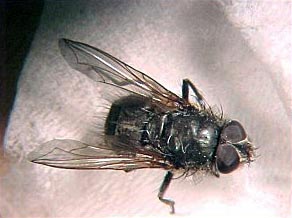Cluster Flies
By Pat Dickey, Fairfax Master Gardener
Have you ever seen large, bristly gray and black flies buzzing inside your home in the wintertime and wondered where they came from? These flies are known as cluster flies.
 Cluster flies (Pollenia rudis) got their name from their habit of clustering together in late summer and early fall on the warm sides of buildings. When the sun goes down, they begin to find a place to hibernate by entering homes and buildings through cracks under the eaves, around windows, or through gaps in the siding. Cluster flies favor attics or protected locations, such as inside walls or under insulation. Strangely, they prefer to migrate and enter buildings or homes on top of hills or on fields with no trees close by.
Cluster flies (Pollenia rudis) got their name from their habit of clustering together in late summer and early fall on the warm sides of buildings. When the sun goes down, they begin to find a place to hibernate by entering homes and buildings through cracks under the eaves, around windows, or through gaps in the siding. Cluster flies favor attics or protected locations, such as inside walls or under insulation. Strangely, they prefer to migrate and enter buildings or homes on top of hills or on fields with no trees close by.
On a warm winter day, or when spring arrives, the flies can be seen coming out of their hiding places and buzzing around loudly or spinning on their sides on windowsills or floors. They enter rooms through electrical outlets and small openings around windows, moldings, and baseboards. They can find their way through gaps in ceiling fans and exhaust fans as well as poorly fitting doors to attics, which is why they are also known as attic flies.
Adult cluster flies are about 7 mm long, larger than common house flies, and have a checkered pattern on their abdomen. The females lay their eggs in cracks in the soil near earthworm burrows. The cluster fly maggots burrow into earthworms, becoming parasites, and emerge as adults after four to five weeks. The flies are more prevalent after an especially wet summer because of an increase in the number of earthworms.
Cluster or attic flies are a nuisance in the home but are otherwise harmless. They do not bite, reproduce inside of buildings, or transmit any form of disease to humans. They do not harm woolens, fur or feathers and do not infest kitchen cupboards. Typically, homes are too hot and dry for the cluster flies to survive in the living areas.
To prevent cluster flies from coming into your home, seal cracks and openings with caulk around the outside of the house and under eaves in the summer and fall. Pay particular attention to the upper part of the house. Install tightly fitting door and window screens. Vacuum any flies you see inside on windowsills and floors. Carefully empty the vacuum canister so that any dead flies do not attract carpet beetles. Light traps or sticky traps will also help to control flies inside the house. To prevent cluster flies from entering the house, professional pesticide applicators can spray approved materials for this purpose around the perimeter of your house. The 2015 Virginia Pest Management Guide lists Fipronil (Termidor), Imidacloprid (Premise), Indoxacarb (Arilon), and Lambda-cyhalothrin(Demand) for use by professionals (and only by professionals) in early fall.
Resources
Cluster Fly, Virginia Cooperative Extension
Cluster Fly, Michigan State University